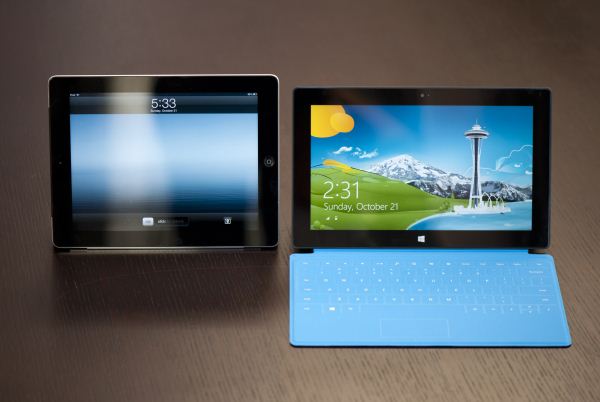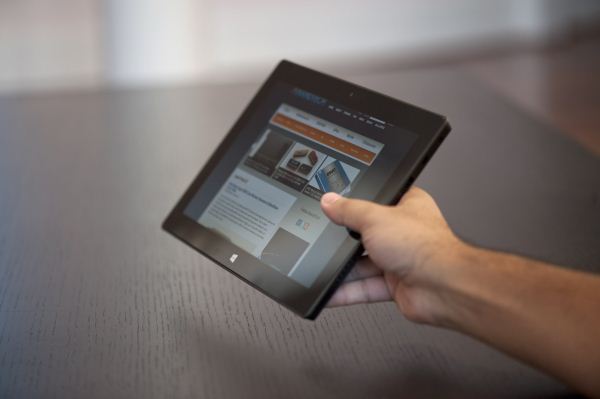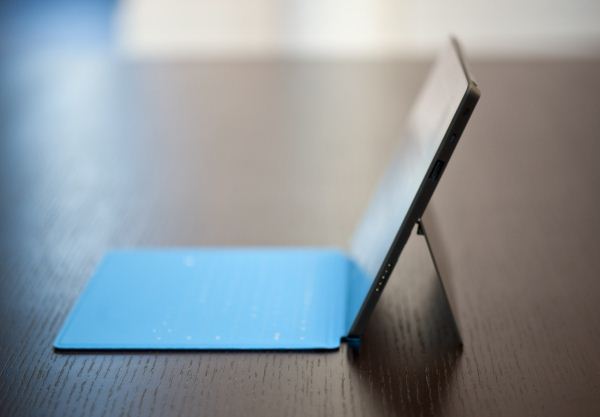Microsoft Surface Review
by Anand Lal Shimpi on October 23, 2012 9:01 PM EST- Posted in
- Tablets
- Microsoft
- Mobile
- Surface
- Windows RT
Surface: Simply Put
Surface is very well built and extremely well designed. It’s easily among the best built products I’ve had the opportunity to handle, and definitely puts a lot of earlier attempts from far more experienced companies to shame. I wouldn’t say that it looks better or worse than the iPad, it’s simply different. I talked about perspectives earlier, Microsoft’s perspective on tablets is a bit more utilitarian than Apple’s and Surface’s design reflects that reality.
Where the iPad is curvy and without any IO expansion, Surface is squared off with 22-degree beveled edges. The iPad features a light aluminum finish while Surface contrasts with its dark Magnesium surface. Not better or worse, just different.
Surface is both larger and heavier than the iPad, both design decisions on Microsoft’s part to built a device that could better deal with Windows RT’s multitasking capabilities as well as make room for a comfortable typing area when used with one of its two keyboard covers.
The added weight is offset by superb internal weight distribution. Microsoft claims a lower moment of inertia by more evenly distributing weight inside Surface’s chassis. I don’t know that I’d consider Surface light but it is very comfortable to carry around. It’s not quite like porting around a pad of paper, but carrying Surface feels very natural.
The focus on weight distribution results in a device that is honestly comfortable to hold in tablet mode and very comfortable to carry around. The more squared design of Surface actually makes in hand feel more like a book than the iPad, which was an early goal for the device.
The chassis is built out of an injection molded Magnesium, which gives it a very different feel to most machined Aluminum or plastic tablets we’ve used in the past. Microsoft calls this process VaporMg (vapor-mag) and I have to say that I’m pleased with the outcome. Surface’s finish is smooth and lacks the same texture that we’ve come to expect from machined Aluminum. The device feels very durable and doesn’t seem to scratch or scuff easily, although I didn’t purposefully try to mar my review unit over the past week. Striking a balance between robustness and light weight is very tricky business when building mobile devices, Surface easily falls on the robust side of the scale without feeling overly heavy. I never felt that the device was too fragile.
The power of Surface is in its flexibility. Microsoft’s talents not as a software developer nor as a parts assembler are what make Surface great here, rather its design and manufacturing intuition. I would’ve expected Surface to come from a company that had much more experience in designing and building tablets and PCs, not from a company that’s traditionally known for putting stickers all over them.
Surface’s flexibility comes from three areas: the tablet itself, the integrated kickstand and the optional Touch/Type covers. In tablet mode, Surface is Microsoft’s take on the new wave of tablets. It delivers the same intimate content consumption experience that you’d get from other tablets but with the added benefits of Windows RT, such as improved multitasking and better task switching.
Surface also features an integrated kickstand, also made out of the same VaporMg process as the rest of the chassis.
Microsoft wants you to be able to quickly transition between notebook, tablet and display modes. It’s rare that I see a goal so well executed. Surface really masters the art of quick transitions between all three modes. I can be in word, typing out this review and quickly switch to a tablet mode where I’m browsing the web with the keyboard cover folded neatly behind the display. If I need to respond to a comment or answer an email, I can just as easily switch back. The kickstand is a necessary part of enabling these quick transitions, and it does its job well.
There’s only one side of Surface that has a cutout for you to easily flick the stand out from its resting place. The kickstand’s range of motion does take some getting used to. It’s spring loaded enough to pop out at good velocity (and strong enough to pinch your skin nicely if you close it on a part of your finger by accident). When deployed it positions the top of Surface away from you at a 22-degree angle, matching the bevel of Surface’s edge.
With a fixed angle of deployment the kickstand doesn’t always deliver the best viewing experience, although it’s usually good enough. The kickstand is perfect for desk use and even for using while reclined on a couch or even in bed. Where it does fall short is if you’re hunched over Surface on an airplane in coach without a lot of room to move the device away from you. In those situations you’re going to find that you’d wish the kickstand could open at a wider angle.
Microsoft is particularly proud of the acoustics and feel of the kickstand. In my experience I felt the kickstand actuated nicely but I don’t know if I’d go so far as to draw the luxury car door comparison. The best way I can put it is the kickstand never feels cheap and doesn’t rattle, it works and gives you the confidence that it’ll always work and not just break after half a year. It’s not often that I find a substantial moving part on a mobile device that I feel is more functional than gimmicky. Surface’s kickstand is definitely a job well done.
The third element of Surface that makes it a very flexible device is also responsible for the splash of color in the design that gives the otherwise business appearance a consumer twist. I’m talking about Surface’s Type and Touch Covers.



















235 Comments
View All Comments
The0ne - Wednesday, October 24, 2012 - link
A few things that caught my attention that would push me to buy one,"Surface is both larger and heavier than the iPad, both design decisions on Microsoft’s part to built a device that could better deal with Windows RT’s multitasking capabilities as well as make room for a comfortable typing area when used with one of its two keyboard covers."
"Whether or not Surface is priced appropriately really depends on how much you value Windows RT and getting Office 2013 for free. I suspect if you’re already a big Office user, you’ll see a lot of value in the bundle."
As much as I abhor the ribbon style in Office, I absolutely love the 2013 Office preview, its metro style UI, the fluidity of working around int he apps. Seriously I love this new office, its such a joy to work in them with the "metro" style inclusions. Therefore getting it for free is a nice touch if I consider buying one. FYI, I have all 3 versions running side by side to test (2003, 2010 and 2013) and 2013 is just so smooth to work in I can live with the ribbon bar (with my fully customized custom bar of course).
As for the weight and comfortable typing, that's even better to use the tablet as a notebook for work and on the road. Can't wait.
Subyman - Wednesday, October 24, 2012 - link
It looks like MS is moving in the right direction. I like how they are splitting the difference between serious computing and be very mobile, unlike what Apple has done. Apple totally killed productivity with the iPad and seem to be trying to go back and mend that decision. MS is offering professionals options for typing, but the device is still totally usable by the normal consumer.I will be interested once the hardware become a bit more powerful. Win RT looks to be hammering the little ARM processor, but that will be worked out over the next year or so.
JoeA - Wednesday, October 24, 2012 - link
Well balanced and written article with positive attributes and things that still can be improved. I’m an early adaptor because I physically work with tech and installs. I’m looking forward to Rev 2 and 3. The transition will not be as hard as some make it out to be. Have fun and yes agreed it’s just different and works very well.Bob Todd - Wednesday, October 24, 2012 - link
Nice review. While there's always something better around the corner, this feels like really unfortunate timing on the CPU/SOC release schedule. On the low end we've got A9 ARM parts at the end of their competitive life, with A15 around the corner (or S4 Pro here would have been sweet). In the middle ground we've got Windows 8 tablets running a 5 year old Atom architecture that's finally about to be overhauled and shrunk to 22nm. Then on the high end we're not far away from Haswell. All 3 of those should provide noticeable improvements to performance (both CPU/GPU) and/or battery life. I'll definitely purchase a Windows 8 tablet, but it won't happen until the next CPU/SOC refresh. A Broadwell based Surface Pro with Thunderbolt/USB3/high res display...yum.Hoekie - Wednesday, October 24, 2012 - link
Nah, you can always wait for something better. Development takes time.The UI is fluid and that's the most important part regarding time to market for SoC's.
Bob Todd - Wednesday, October 24, 2012 - link
Apps are slow to launch. This thing can't really have a higher res panel because of Tegra 3 limitations. The moves to A15 class or the next Atom aren't little 10% spec bumps that we're used to on the desktop side. We're talking about very noticeable improvements to the user experience. S4 Pro devices are going to be available here next week. I'd buy a Surface RT right now with an S4 Pro and a 1920x1080 panel. If they added another $50 for the panel I wouldn't mind. Like I said, there's always something better around the corner, but this thing is making its debut at the twilight of 3 architectures (A9, Atom, Ivy). I'm not saying _they_ should have waited, I'm saying I'm going to wait because they can refresh both RT and Pro versions in a few months with changes that really matter (cpu/gpu/battery life) in a device designed for productivity. Every SOC refresh will get better, it's just that the next ones are major and are so close.Bob Todd - Wednesday, October 24, 2012 - link
Apps are slow to launch. This thing can't really have a higher res panel because of Tegra 3 limitations. The moves to A15 class or the next Atom aren't little 10% spec bumps that we're used to on the desktop side. We're talking about very noticeable improvements to the user experience. S4 Pro devices are going to be available here next week. I'd buy a Surface RT right now with an S4 Pro and a 1920x1080 panel. If they added another $50 for the panel I wouldn't mind. Like I said, there's always something better around the corner, but this thing is making its debut at the twilight of 3 architectures (A9, Atom, Ivy). I'm not saying _they_ should have waited, I'm saying I'm going to wait because they can refresh both RT and Pro versions in a few months with changes that really matter (cpu/gpu/battery life) in a device designed for productivity. Every SOC refresh will get better, it's just that the next ones are major and are so close.Swift2001 - Wednesday, October 24, 2012 - link
People like yourfather239 -- interesting nickname -- are trolls. We, the sane people of the AnandTech comments, should be able to kick him off -- or demand attention of the site runner to read the exchange and kick him off. Even a reasonable discussion of racism and the dynamics of it would be okay on another site. But this guy is not contributing a thing. He's a bigot. He should not be rewarded by our attention.OldAndBusted - Wednesday, October 24, 2012 - link
Then again, your name calling is pretty ugly too.IKeelU - Wednesday, October 24, 2012 - link
Nice false equivalence, ace. Swift2001's "name calling" can be observed to be accurate, unlike the racist he's calling out.